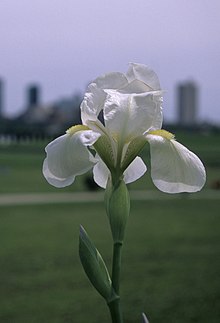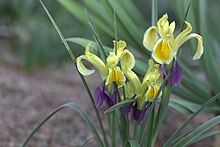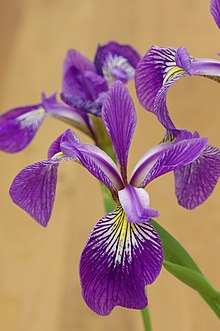Irises
| Irises | ||||||||||||
|---|---|---|---|---|---|---|---|---|---|---|---|---|
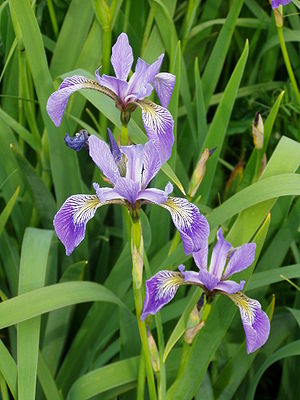
Different colored iris ( Iris versicolor ) |
||||||||||||
| Systematics | ||||||||||||
|
||||||||||||
| Scientific name | ||||||||||||
| iris | ||||||||||||
| L. |
The irises ( Iris ) form a genus of plants in the subfamily Iridoideae in the family of the Iris family (Iridaceae) within the monocot plants .
The genus, which is extensive in species, with yellow, blue or multi-colored petals, was named after the rainbow (Greek iris ) like the Greek goddess of the rainbow ( iris ) . The scientific name is also common in German usage. The iris species are valued as ornamental plants because of their beautiful and showy flowers. Irises, despite their name, are only distantly related to lilies .
Description and ecology
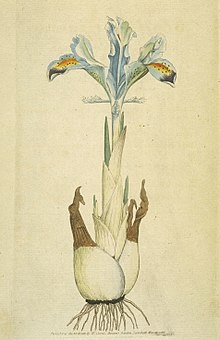

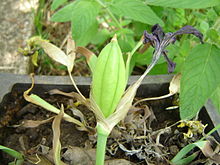
Vegetative characteristics
Iris species are perennial herbaceous plants . These geophytes form rhizomes or tubers , which are often inappropriately called "onions", as organs of persistence. Recently, the species of the genus Belamcanda (for example Belamcanda chinensis , now: Iris domestica ) have been included in Iris . The following description applies to all Iris species that did not belong to the genus Belamcanda .
Generative characteristics
The hermaphrodite flowers of the irises are threefold. There are six bracts that are fused together like a trumpet; three outer so-called “hanging leaves” with the buds always turned to the left and which in some species have conspicuous combs or beards, as well as three inner, often upright “standards”. Above each “ hanging leaf ” there is a stigma shaped and colored like a flower bract . There are only three stamens . The stylus is “three-branched”, with each “stylus load” being bilobed above the scar. In terms of pollination biology, each "hanging leaf" forms a flower (meranthium) with a stigma and the stamen in between . H. every third of the flower can be approached independently by insects (especially bumblebees ) ( entomogamy ).
The lokuliziden cap fruits tear each at maturity at the back seams carpel on. In addition to irises, such capsule fruits are also found in daffodils , evening primrose and many other lily plants . There are 4 to 20 seeds in one or two rows per capsule compartment. The seeds are with or without aril .

Systematics and distribution
The genus Iris was established by Carl von Linné . Synonyms for Iris Tourn. ex L. are: Hermodactylus Mill. , Xiphion Mill. , Xyphion Medik. orth. var., Belamcanda Adans. nom. cons., Beverna Adans. , Chamoletta Adans. , Gemmingia Heist. ex Fabr. , Iriastrum Heist. ex Fabr. , Xuris Adans. , Chamaeiris medic. , Gattenhofia Medik. , Pseudo-iris medic. , Xeris medic. , Pardanthus Ker Gawl. , Evansia Salisb. , Thelysia Salisb. , Juno Tratt. , Limniris (exchange) Rchb. , Oncocyclus Siemssen , Limnirion Opiz , Costia Willk. , Coresantha Alef. , Neubeckia Alef. , Spathula Fourr. , Xyridion (exchange) Fourr. , Joniris (Spach) Klatt , Ioniris Baker orth. Var., Cryptobasis Nevski , Sclerosiphon Nevski , Iridodictyum Rodion. , Siphonostylis Wern.Schulze , Junopsis Wern.Schulze , Pardancanda L.W.Lenz , Pardanthopsis (Hance) LWLenz , Alatavia Rodion. , Ophioiris (YTZhao) Rodion. , Eremiris (Spach) Rodion. , Dielsiris M.B.Crespo , Lophiris (exchange) MBCrespo , Phaeiris (Spach) MBCrespo , Rodionenkoa M.B.Crespo, Mart.-Azorín & Mavrodiev , Syrianthus M.B.Crespo, Mart.-Azorín & Mavrodiev , Tectiris M.B.Crespo, Mart.-Azorín & Mavrodiev , Zhaoanthus M.B. Crespo , Mart.-Azorín & Mavrodiev .
Internal system
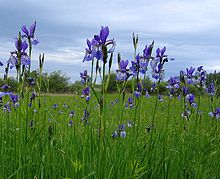
The genus Iris is divided into six sub-genera:
- Subgenus Hermodactyloides Spach : They have tubers.
- Subgenus Iris : They have rhizomes : With the sections :
- Hexapogon section
- Iris section
- Section Oncocycle
- Section Psammiris (Spach) JJTaylor
- Section Pseudoregelia
- Section Regelia
- Subgenus Limniris (exchange) Spach : They have rhizomes: With the sections:
- Limniris Exchange Section
- Section Lophiris Swap
- Subgenus Nepalenses : They have rhizomes.
- Subgenus Scorpiris Spach : They have tubers.
- Subgenus Xiphion (Mill.) Spach .
Species and their distribution


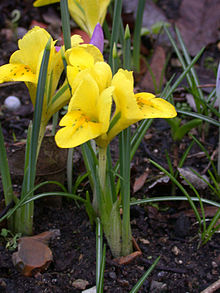



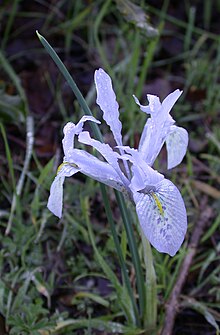


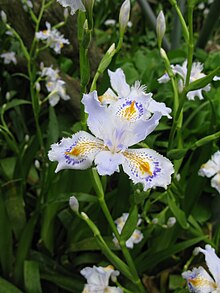


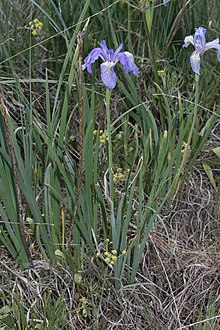




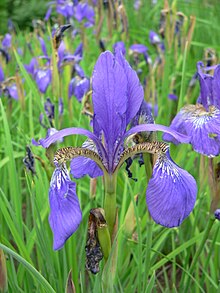






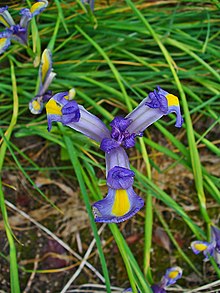
The 200 to 285 species all come from the northern hemisphere , mostly from the temperate zones . In the temperate areas of Asia there are 241 species, in Western Asia 117 species, in China 61 species, in Central Asia 70 species and in Afghanistan 34 species.
The World Checklist of Selected Plant Families lists the following 304 species (as of 2020):
- Iris acutiloba C.A. Mey. : There are three subspecies:
- Iris adriatica Trinajstic ex Mitic : It wasfirst describedfrom Croatia in 2002.
- Iris afghanica Wendelbo : It occurs in northeastern Afghanistan .
- Iris aitchisonii (Baker) Boiss. : It occurs from eastern Afghanistan to the western Himalayas .
- Iris alberti's rule : It is common in Central Asia.
- Iris albicans Lange : It is originally found in Saudi Arabia and Yemen .
- Iris albomarginata R.C. Foster : It occurs in Kazakhstan .
- Iris alexeenkoi Grossh. : It occurs in the central and eastern Caucasus .
- Iris almaatensis Pavlov : It occurs only in southern Kazakhstan.
- Iris anguifuga Y.T.Zhao & XJXue : It thrives on slopes and in grasslands in the Chinese provinces of Anhui , Guangxi and Hubei.
- Iris antilibanotica Dinsm. : It occurs in Syria .
- Naked stem iris ( Iris aphylla L. ): Home: from Central Europe and Italy to Russia and Asia Minor .
- Iris arenaria Waldst. & Kit. : It occurs in Central and Eastern Europe .
- Iris assadiana Chaudhary, G. Kirkw. & C.Weymouth : It occurs in Syria.
- Iris atrofusca Baker : It is only found in Israel .
- Iris atropatana Grossh. : It occurs from north-eastern Turkey to southern Transcaucasia .
- Iris atropurpurea Baker : It is only found in Israel.
- Aucher iris ( Iris aucheri (Baker) Sealy , Syn .: Iris sindjarensis Boiss. & Hausskn. ): It occurs from southeastern Turkey to Iraq, Palestine and western Iran.
- Iris auranitica Dinsm. : It occurs in Syria.
- Iris austrotschatkalica Tojibaev, F.Karimov & Turgunov : It wasfirst describedin 2014 from Uzbekistan .
- Iris avromanica Ruksans : It was first described from Iran in 2019.
- Baker's iris ( Iris bakeriana Foster ): It occurs from eastern Turkey to western Iran. It is also referred to as Iris reticulata var. Bakeriana (Foster) B.Mathew & Wendelbo as Iris reticulata variety .
- Iris baldshuanica O. Fedsch. : It occurs from southern Tajikistan to northeastern Afghanistan.
- Iris barbatula Noltie & KYGuan : It thrives on grassy plains at altitudes of 2400 to 3600 meters only in Yunnan.
- Iris barnumiae Foster & Baker : Of the two subspecies, one occurs only in northern Iran and the other from eastern Turkey via northeastern Iraq to northern Iran.
- Iris basaltica Dinsm. : It occurs in Syria.
- Iris benacensis A. Kern. ex Stapf : This endemic occurs only on Monte Brione on Lake Garda.
- Iris bicapitata Colas. : This endemic occurs only in southeastern Italy.
- Iris biglumis Vahl : It occurs only in southern Siberia .
- Iris bismarckiana Dammann & Sprenger : It occurs from the Hermon in southern Lebanon to northern Israel.
- Iris bloudowii Ledeb. : It occurs from Central Asia via Xinjiang to Mongolia .
- Iris boissieri Henriq. : It occurs only in northern Portugal and northwestern Spain .
- Iris bostrensis Mouterde : It occurs in Syria.
- Siskiyou iris ( Iris bracteata S. Watson ): It occurs in the western United States from southern Oregon to northern California .
- Louisiana Iris ( Iris brevicaulis Raf. ): It occurs from Ontario to the northern, central, and eastern United States.
- Bukhara iris or antler iris ( Iris bucharica Foster ): Origin: Central Asia (Tajikistan), northeastern Afghanistan.
- Iris bulleyana Dykes : It occurs in northern Myanmar , Tibet and in the Chinese provinces of Sichuan and Yunnan.
- Iris bungei Maxim. : It occurs in Mongolia, Inner Mongolia and the Chinese provinces of Gansu , Ningxia and Shanxi .
- Iris cabulica Gilli : It occurs in eastern Afghanistan.
- Iris calabra (N. Terracc.) Peruzzi : It occurs only in southern Italy.
- Iris camillae Grossh. : It occurs in the eastern Transcaucasia.
- Iris capnoides (Vved.) T. Hall & Seisums : It occurs in Central Asia.
- Iris carterorum B.Mathew & Wendelbo : It occurs in eastern Afghanistan.
- Iris cathayensis Migo : It thrives in open locations on hills and in grasslands in the Chinese provinces of Anhui , Hubei , Jiangsu and Zhejiang .
- Iris caucasica Hoffm. : It occurs in four subspecies from Turkey to the Caucasus and northern Iran.
- Iris cedreti Dinsm. ex Chaudhary : It only occurs in Lebanon .
- Iris celikii Akbulat & KIChr. : It was first described in 2006 from Turkey.
- Gold-stripe iris ( Iris chrysographes Dykes ): It occurs only in northeastern Myanmar, Tibet and the Chinese provinces of Guizhou, Sichuan, and Yunnan.
- Iris chrysophylla Howell : Homeland: Oregon, Northern California.
- Iris Clarkei Baker ex Hook. f. : It occurs from the Himalayas (northeastern India, Bhutan, Sikkim, Nepal) Myanmar, Tibet to western Yunnan .
- Iris colchica Kem.-Nath. : It occurs in the Caucasus region.
- Iris collettii Hook. f. : Of the two varieties, one occurs only in Sichuan and Yunnan and the other in Sichuan and Yunnan, Tibet, northeastern India, Myanmar, Thailand, Vietnam and perhaps Nepal.
- Iris confusa Sealy : It thrives on the edges of forests, open gorges, grass hills and moats at altitudes of 1,600 to 2,400 meters in the Chinese provinces of Guangxi, Guizhou, Sichuan and Yunnan.
- Comb iris ( Iris cristata Soland. Ex Aiton ): Home to the northern, eastern, and central United States.
- Cashmere Iris ( Iris crocea Jacquem. Ex RCFoster ): The home is the western Himalayas.
- Iris cuniculiformis Noltie & KYGuan : It thrives on grassy plains at altitudes of 3100 to 4000 meters in Sichuan and Yunnan.
- Iris curvifolia Y.T.Zhao : It thrives on grasslands on hills only in Xinjiang .
- Around tongue iris ( Iris cycloglossa Wendelbo ): It occurs only in northwestern Afghanistan.
- Iris damascena Mouterde : It occurs on Mount Qasioun near Damascus in Syria.
- Danford Iris ( Iris danfordiae (Baker) Boiss. ): Origin: Asia Minor.
- Iris darwasica rule : It occurs from Tajikistan to Afghanistan.
- Iris decora wall. (Syn .: Iris nepalensis D. Don ): It occurs from northern India via Bhutan and Nepal to Pakistan, Tibet and the Chinese provinces of Sichuan and Yunnan.
- Delavay iris ( Iris delavayi Micheli ): It thrives on the edges of forests, in meadows, in damp locations along moats at altitudes of 2,400 to 4,500 meters in Tibet and in the Chinese provinces of Guizhou, Sichuan and Yunnan.
- Iris dichotoma Pall. (Syn .: Pardanthopsis dichotoma (Pall.) IWLenz ): It is in Korea , Siberia , Mongolia , Inner Mongolia and the Chinese provinces of Anhui, Gansu, Hebei , Heilongjiang , Henan , Hubei , Hunan , Jiangxi , Jilin , Liaoning , Ningxia , Shaanxi , Shandong , Shanxi and Yunnan are widely used.
- Iris doabensis B.Mathew : It occurs in Afghanistan.
- Iris dolichosiphon Noltie : Of the two subspecies, one occurs in northeastern India, Myanmar, Sichuan and Yunnan, and the other occurs in Tibet and Bhutan .
- Leopard flower ( Iris domestica (L.) Goldblatt & Mabb. , Syn .: Belamcanda chinensis (L.) Redouté ): It occurs originally from the Himalayas to Japan and the Philippines.
- Douglas-Iris ( Iris douglasiana Herb. ): Homeland: Oregon, California.
- Iris drepanophylla Aitch. & Baker : It occurs in two subspecies from northeastern Iran to northern Afghanistan.
- Iris edomensis Sealy : It is only found in Jordan .
- Japanese Swamp Iris ( Iris ensata Thunb. , Syn .: Iris haematophylla Fisch. Ex Link , Iris kaempferi Sieb. ): It is in southeastern Siberia, Korea , Japan and the Chinese provinces of Heilongjiang, Jilin, Liaoning, Shandong and Zhejiang spread.
- Iris falcifolia Bunge : It occurs from Pakistan and Iran to Central Asia.
- Iris farashae Güner : It was first described from Turkey in 2012.
- Iris farreri Dykes : It thrives in open pine forests, on meadows, sunny banks and in damp locations near rivers at altitudes of 2500 to 3700 meters in Tibet and in the Chinese provinces of Gansu, Qinghai, Sichuan and Yunnan.
- Iris ferdowsii Joharchi & Memariani : It was first described from Iran in 2017.
- Iris fernaldii R.C. Foster : It is only found in northwestern California.
- Iris filifolia Boiss. : The homeland is southern Spain and northern Morocco .
- Malodorous iris ( Iris foetidissima L. ): It is originally found from Western Europe to the western and central Mediterranean and the Azores .
- Iris formosana Ohwi : This endemic thrives on the edges of forests, on hills and on roadsides at altitudes of 500 to 1000 meters in northwestern Taiwan .
- Forrest iris ( Iris forrestii Dykes ): It occurs in Myanmar, Tibet and in the Chinese provinces of Sichuan and Yunnan .
- Iris fosteriana Aitch. & Baker : It occurs in Iran, northwestern Afghanistan and Turkmenistan .
- Terracotta iris or copper iris ( Iris fulva Ker ): It occurs in the north-central and south-eastern United States.
- Iris furcata M.Bieb. : The homeland is the Caucasus.
- Iris furseorum T. Hall & Seisums : It was first described from Afghanistan in 2014.
- Iris galatica See : It occurs in central and eastern Turkey.
- Iris gatesii Foster : It occurs from southeastern Turkey to northern Iraq.
- Iris giganticaerulea Small : It is found in the southeastern United States.
- Iris glaucescens Bunge : It occurs from southwestern Siberia to northwestern Mongolia.
- Iris goniocarpa Baker : It is found in the Himalayas (Bhutan, Nepal, Sikkim, Myanmar), in Tibet and in the Chinese provinces of Gansu, Hubei, Qinghai, Shaanxi, Sichuan and Yunnan.
- Japanese dwarf iris ( Iris gracilipes A.Gray ): Origin: Japan.
- Graeber Iris ( Iris graeberiana Sealy ): Origin : Central Asia.
- Grass Iris ( Iris graminea L. ): Origin: Europe.
- Iris grant-duffii Baker : It occurs from Turkey to Iraq.
- Iris griffithii Baker : It occurs in eastern Afghanistan.
- Iris grossheimii Voronow ex Grossh. : It occurs in the southern Transcaucasia.
- Iris halophila Pall. : The two varieties are distributed from Romania , Ukraine to Pakistan and Mongolia and in Gansu and Xinjiang .
- Iris hartwegii Baker : It occurs in California.
- Iris haynei Baker : This endemic occurs in northern Israel only in the Gilboa Mountains.
- Iris hellenica Mermygkas : It was first described from Greece in 2010.
- Iris henryi Baker : It thrives on the edges of forests, grass-covered clearings and grass slopes on hot, dry mountains at altitudes of 1,800 to 1,900 meters in the Chinese provinces of Anhui, Gansu, Hubei, Hunan and Sichuan.
- Iris heracleana (J.Mart.Rodr. & MBCrespo) T.Hall (Syn .: Xiphion heracleanum J.Mart.Rodr. & MBCrespo ): It occurs in Morocco.
- Iris Hermona Dinsm. : It occurs from southwestern Syria to Lebanon.
- Iris heweri Gray-Wilson & B. Mathew : It occurs only in northeast Afghanistan.
- Iris hexagona Walter : The home is northern Florida and eastern South Carolina .
- Iris heylandiana Boiss. & Reut. : It occurs in Iraq.
- Iris hippolyti (Vved.) Kamelin : It occurs in Uzbekistan .
- Light blue dwarf iris ( Iris histrio Rchb. F. ): It occurs from southern Turkey to Lebanon.
- Small dwarf iris ( Iris histrioides (GFWilson) S.Arn. , Syn .: Iris reticulata var. Histrioides G.F.Wilson ): It occurs in northern Turkey.
- Hoog iris ( Iris hoogiana Dykes ): Origin : Central Asia.
- Iris hookeri Penny ex G.Don : It is found in eastern Canada and Maine .
- Iris hookeriana Foster : It occurs from Afghanistan to the western Himalayas.
- Sand iris ( Iris humilis Georgi , Syn .: Iris arenaria Waldst. & Kit. , Iris flavissima Pall. , Iris flavissima Pall. F. Orientalis Ugr. ): It comes from eastern European Russia to northern China (it is in the Flora of China not included).
- Iris hymenospatha B.Mathew & Wendelbo : It occurs in two subspecies in Iraq and Iran.
- Iris iberica Steven : It occurs in three subspecies from northeastern Turkey to western Iran.
- Iris imbricata Lindl. : It occurs from the eastern Caucasus to northern Iran.
- Iris inconspicua (Vved.) T. Hall & Seisums (Syn .: Juno inconspicua Vved. ): It occurs in Central Asia in the western Tian Shan .
- Rainbow Iris ( Iris innominata L.F.Hend. ): Origin: southwestern Oregon, northwestern California.
- Iris ivanovae Doronkin : It occurs from southern Siberia to Mongolia.
- Fringed iris ( Iris japonica Thunb. ): It occurs in Japan, in large parts of China and in Myanmar.
- Iris juncea Poir. : It occurs in southwestern Spain, Sicily, Morocco, Algeria, Tunisia and Libya and is a neophyte in Italy.
- Iris junonia Schott : It occurs in southern Turkey.
- Iris kamelinii Alexeeva : It wasfirst describedin 2006 from the south-eastern Altai .
- Iris kashmiriana Baker : It occurs in the western Himalayas.
- Iris kemaonensis Wall. ex D.Don : It occurs in northern India, Bhutan, Nepal and in Tibet.
- Iris kerneriana Asch. & Sint. ex Baker : It occurs in eastern Turkey.
- Iris khassanovii Tojibaev & Turginov : The species was first described from Uzbekistan in 2014.
- Iris kirkwoodiae Chaudhary : It occurs in two subspecies from southern Turkey to western Syria.
- Iris kobayashii Kitag. : This endemic thrives on dry hills only in the southern part of the Chinese province of Liaoning .
- Iris kolpakowskiana rule : It occurs in two subspecies in Central Asia.
- Iris koyuncui Firat : It was first described in 2016 from the southeastern Turk.
- Iris kopetdagensis (Vved.) B.Mathew & Wendelbo : It occurs from northeastern Iran to Turkmenistan and Afghanistan.
- Iris koreana Nakai : It occurs in central and southern Korea.
- Korolkow iris ( Iris korolkowii rule ): Origin: Central Asia, Afghanistan.
- Iris kurbanovii F.O.Khass. & Rakhimova : It wasfirst describedfrom Turkmenistan in 2012.
- Iris kurdica (Rukšans) Ruksans : It occurs in eastern Turkey.
- Iris kuschakewiczii B. Fedsch . : It occurs in Central Asia.
- Iris kuschkensis Gray-Wilson & B.Mathew : It is only found in northwestern Afghanistan.
- Iris lactea Pall. : The three forms are common in northern India, Pakistan, Afghanistan, Kazakhstan, Korea, Mongolia, Russia, and China.
- Sea iris or American dwarf iris ( Iris lacustris Nutt. ): It occurs in North America in the Canadian province of Ontario and in the US states of Michigan and Wisconsin.
- Asiatic iris ( Iris laevigata Fisch. ): It occurs in Japan, Korea, Russia, Inner Mongolia and in the Chinese provinces of Heilongjiang, Jilin, Liaoning and Yunnan.
- English Iris or Pyrenean Iris ( Iris latifolia (Mill.) Voss , Syn .: Iris xiphioides Ehrh. ): Origin: Spain and France.
- Iris latistyla Y.T.Zhao : It thrives on the edges of forests and in grasslands near rice fields at altitudes of 3100 to 4000 meters only in southeastern Tibet.
- Iris lazica Albov : Origin: Caucasus region, north-eastern Turkey.
- Iris leptophylla Lingelsh. ex H. Limpr. (Syn .: Iris sichuanensis Y.T.Zhao ): You on grassy hills and on rocky slopes at altitudes of 2600 to 3200 meters in the Chinese provinces of Gansu and Sichuan.
- Iris leptorrhiza (Vved.) Vved. : It occurs in Tajikistan.
- Iris lineata Foster ex rule : It occurs from Tajikistan to northeast Afghanistan.
- Iris linifolia (Regel) O.Fedtsch. : It occurs in Kyrgyzstan, Tajikistan and Uzbekistan .
- Iris linifoliiformis (Khalk.) Tojibaev & Turginov : It occurs in Turkmenistan.
- Iris loczyi Kanitz : It is widespread from Iran to Tajikistan to Afghanistan, Russia, Mongolia and China.
- Iris lokiae Alexeeva : She wasfirst describedin 2013 from the Russian administrative area of Primorsky Krai .
- Iris longipetala Herb. : It only occurs in western California.
- Iris longiscapa Ledeb. : It occurs in Central Asia.
- Iris lortetii Barbey ex Boiss. : It occurs in two varieties from Lebanon to northern Israel.
- Iris ludwigii Maxim. : It occurs from the southern Altai to northeastern Kazakhstan.
- Iris lusitanica Ker : It occurs in Portugal.
- Yellowish Iris or Greenish Iris ( Iris lutescens Lam .; Syn .: Iris chamaeiris Bertol. ): It is native to Portugal, northeastern Spain, southern France and Italy. It is a neophyte in Switzerland and North Africa.
- Iris maackii Maxim. : It occurs from the Chinese provinces of eastern Heilongjiang and Liaoning to southern Sakhalin .
- Iris macrosiphon Torr. : It occurs in California.
- Great Iris ( Iris magnifica Vved. ): It is found in Kazakhstan, Tajikistan and Uzbekistan.
- Iris mandshurica Maxim. : It occurs in Russia, Korea and in the Chinese provinces of Heilongjiang, Jilin and Liaoning.
- Iris maracandica (Vved.) Wendelbo : It occurs in Central Asia.
- Iris mariae Barbey : It occurs from southern Israel to the Sinai Peninsula.
- Iris marivanica Ruksans : The species first described in 2019 occurs in Iran.
- Iris marsica I. Ricci & Colas. : This endemic occurs only in the central Appennine .
- Iris masiae Dykes : It occurs in two subspecies from Turkey to northwestern Iraq.
- Iris meda Stapf : It occurs in western Iran.
- Iris microglossa Wendelbo : It occurs in northeastern Afghanistan.
- Iris milesii Foster : It occurs in northwestern India, Tibet and in the Chinese provinces of Sichuan and Yunnan.
- Iris minutoaurea Makino : It occurs in Japan, Korea and in the southeastern part of the Chinese province of Liaoning.
- Rocky Mountain Iris ( Iris missouriensis Nutt. ): It is distributed in North America from Canada through the USA to northeast Mexico .
- Iris munzii R.C. Foster : It only occurs in central California.
- Iris mzchetica Rodion. : It occurs in Transcaucasia.
- Iris nantouensis S.S.Ying : It occurs in central Taiwan.
- Iris narbutii O.Fedtsch. : It occurs in Central Asia.
- Iris narcissiflora Diels : It thrives on grass hills, in clearings and on the edges of forests in Sichuan. in front.
- Iris narynensis O. Fedsch . : It occurs in Central Asia.
- Iris nectarifera Güner : It occurs in two varieties in southeastern Turkey.
- Iris neoensata Y.N.Lee : It was first described in 2005 South Korea.
- Iris neosetosa Y.N.Lee : It was first described in 2002 northeastern China.
- Iris nezahatiae Güner & H.Duman : It was first described in 2007 from northeastern Turkey.
- Iris nicolai (Vved.) Vved. :: It occurs in Tajikistan and Uzbekistan.
- Black Iris ( Iris nigricans Dinsm. ): Home: Palestine.
- Iris notha M.Bieb. : It occurs in the Caucasus region.
- Iris nusairiensis Mouterde : This endemic occurs in Syria only in the Jebel Ansariye .
- Iris odaesanensis Y.N.Lee : It occurs in Korea and Jilin .
- Iris odontostyla B.Mathew & Wendelbo : It occurs in northwestern Afghanistan.
- Iris orchioides Carr. : Home: Central Asia.
- Oriental iris or butterfly iris ( Iris orientalis Mill. ): Origin: northeastern Greece, western Turkey.
- Orjen iris ( Iris orjenii Bräuchler & Cikovac ): It is endemic to Orjen in Montenegro and occurs there in the border region of Montenegro and Bosnia and Herzegovina .
- Iris oxypetala Bunge : It occurs from northern China to Japan.
- Iris palaestina (Baker) Boiss. : It occurs in the area of Syria, Lebanon and Palestine.
- Iris pallasii fish. ex Trevir. : It occurs from southern Siberia to Mongolia.
- Pale Iris ( Iris pallida Lam. ): Of the three subspecies, one occurs only in northern Italy and the other two in the southern Alps from northern Italy to Slovenia .
- Pamphylian Iris ( Iris pamphylica Hedge ): Origin: southern Turkey.
- Iris paradoxa Steven : It occurs from eastern Turkey to northwestern Iran.
- Iris parvula (Vved.) T. Hall & Seisums : It occurs in Central Asia.
- Iris perrieri Simonet ex N.Service : This species, first described in 2003, occurs in the south-western Alps of France and Italy.
- Iris persica L .: Homeland: southern Turkey, northern Syria, north-eastern Iraq.
- Iris peshmeniana Güner & T. Hall : It was first described in 2012 from Turkey.
- Iris petrana Dinsm. : It occurs in western Jordan.
- Iris petri F.O.Khass., Rakhimova & Achilova : She was first described in 2014 from Uzbekistan.
- Iris planifolia (Mill.) T.Durand & Schinz : It is common in the western and central Mediterranean region.
- Iris platyptera B.Mathew & Wendelbo : It occurs from eastern Afghanistan to northwestern Pakistan.
- Iris polakii Stapf : It occurs in western Iran.
- Iris pontica Zapal. : Homeland: Romania, Western Ukraine, Caucasus.
- Iris popovii (Vved.) Vved. : It occurs in Central Asia.
- Iris porphyrochrysa Wendelbo : It occurs in central Afghanistan.
- Iris postii Mouterde : It occurs from eastern Syria to northern Saudi Arabia .
- Iris potaninii Maxim. : The two varieties are distributed from southern Siberia via Mongolia and Tibet to the Chinese provinces of Gansu and Qinghai .
- Iris prismatica Pursh ex Ker Gawl. : Home: USA.
- Iris proantha Diels : Of the two varieties, one occurs only in Zhejiang and the other also occurs in Anhui, Henan, Hubei, Hunan and Jiangsu.
- Iris psammocola Y.T.Zhao (Syn .: Iris potaninii var. Arenaria Doronkin): It occurs in southern Siberia and Inner Mongolia.
- Swamp iris or water iris ( Iris pseudacorus L. ): native to North Africa, Europe, western Asia and the Caucasus.
- Iris pseudocapnoides Rukšans : It was first described from Uzbekistan in 2007.
- Iris pseudocaucasica Grossh. : Homeland: Southeastern Turkey, Caucasus, Northern Iraq, Iran.
- Iris pseudonotha Galushko : It occurs in the north-eastern Caucasus.
- Sicilian dwarf iris ( Iris pseudopumila Tineo ): It occurs in two subspecies on Sicily, Malta, southeastern Italy and the northwestern Balkan peninsula.
- Iris pskemensis Rukšans : It was first described from Uzbekistan in 2007.
- Dwarf iris ( Iris pumila L. ): native to Austria, the Balkans , Asia Minor and the Caucasus. With two subspecies.
- Iris purdyi Eastw. : It occurs in northern California.
- Iris purpureobractea B.Mathew & T.Baytop : Origin : Turkey and Caucasus.
- Iris qinghainica Y.T.Zhao : It thrives in sunny meadows, in mountain locations and on loess hills at altitudes of 2500 to 3100 meters only in southwestern Gansu and northeastern Qinghai .
- Iris ramsayi T. Hall & B.Mathew : She wasfirst describedin 2013 from Arunachal Pradesh .
- Iris regis-uzziae Feinbrun : It occurs in Israel and in southern Jordan.
- Irisreichenbachiana Klatt : It occurs in Spain, France, Italy, Algeria and Tunisia.
- Reichenbach iris ( Iris reichbachii Heuff. ): It occurs from Hungary and the former Yugoslavia to Greece.
- Iris relicta Colas. : It occurs in central Italy.
- Reticulated Iris or Reticulated Iris ( Iris reticulata M.Bieb. ): Native to the Caucasus region, Turkey, Iraq, Iran.
- Iris revoluta Colas. : It occurs only in southern Italy .
- Iris rodionenkoi (Lazkov & Naumenko) T. Hall : It occurs in Kyrgyzstan.
- Iris rosenbachiana rule : It occurs from Tajikistan to northeast Afghanistan.
- Iris rossii Baker : It occurs in the northeastern part of the Chinese province of Liaoning , in Korea and Japan.
- Iris rudolphii F.O.Khass., Esankulov & Achilova : It wasfirst describedfrom Uzbekistan in 2013.
- Transylvanian grass iris ( Iris ruthenica Ker Gawl. ): The two subspecies are widespread from Southeastern Europe (Romania) via Kazakhstan and Russia, Mongolia, China to Korea.
- Iris rutherfordii J.Mart.Rodr., P.Vargas, Carine & Jury : It was first described in 2009 from northern Morocco.
- Iris sabina N. Terracc. : This endemic occurs only in central Italy.
- East Siberian Iris ( Iris sanguinea Hornem. Ex Donn ): One of the four varieties has been lost; it only occurred in southern Jiangsu. One variety is found only in Korea and one is endemic to the Japanese island of Kyushu . The nominate form is common in Japan, Korea, Eastern Siberia , Mongolia, Inner Mongolia and the Chinese provinces of Heilongjiang, Jilin and Liaoning.
- Iris sari Schott ex Baker : Home: Turkey.
- Iris savannarum Small : It is found in the southeastern United States.
- Iris scariosa Willd. ex Link (Syn .: Iris astrachanica Rodion. , Iris elongata Fisch. ex Baker , Iris eulefeldii Regel ): It occurs in Xinjiang, Kazakhstan and Russia.
- Iris schachtii Markgr. : It occurs only in central Turkey.
- Iris schelkownikowii (Fomin) Fomin : It occurs in the eastern Transcaucasia.
- Iris schischkinii Grossh. : It occurs in the southern Transcaucasia.
- Iris schmakovii Alexeeva : The species first described in 2018 occurs in Mongolia.
- Iris serotina Willk. : It occurs in Spain and northern Morocco.
- Iris setina colas. : It occurs only in central Italy .
- Bristle Iris ( Iris setosa Pall. Ex Link ): It occurs from eastern Jilin through eastern Siberia, Korea and Japan to Alaska and eastern Canada.
- Siberian iris or meadow iris ( Iris sibirica L. ): It occurs from Central Europe to Mongolia.
- Sintenis iris ( Iris sintenisii Janka ): It occurs in two subspecies from southeast and eastern Europe to northern Turkey.
- Iris sisianica Zubov & Bondarenko : She wasfirst describedin 2018 from southern Transcaucasia .
- Iris songarica Schrenk : Home: Turkey, Iran, Central Asia, Kashmir , China, Mongolia.
- Iris sophenensis (Foster) B.Mathew & Güner : It occurs in Turkey.
- Iris speculatrix Hance : It occurs in China.
- Iris sprengeri See : It occurs in central Turkey.
- Bastard iris or steppe iris ( Iris spuria L. ): It occurs in four subspecies from northern Central Europe to Iran.
- Iris staintonii H.Hara : This endemic occurs only in Nepal.
- Iris statellae death. : This endemic occurs only in Sicily .
- Iris stenophylla Hausskn. ex Baker : It occurs in three subspecies in Turkey.
- Iris stocksii (Baker) Boiss. : It occurs from eastern Afghanistan to western Pakistan.
- Silver iris ( Iris stolonifera Maxim. ): Origin: Central Asia.
- Iris straussii Leichtlin ex Micheli : It occurs in western Iran.
- Multi-colored dwarf iris ( Iris suaveolens Boiss. & Reut. , Syn .: Iris mellita Janka ): Origin: Balkan Peninsula, Romania, Turkey.
- Iris subdecolorata Vved. : It occurs in Central Asia.
- Iris subdichotoma Y.T.Zhao : It occurs in Yunnan .
- Lady in mourning ( Iris susiana L. ): It occurs in Lebanon.
- Iris svetlanae (Vved.) FOKhate. : It occurs in Central Asia.
- Iris swensoniana Chaudhary, G. Kirkw. & C.Weymouth : It occurs in Syria.
- Iris tadshikorum (Vved.) Vved. : It occurs in Tajikistan .
- Iris taochia Voronow ex Grossh. : It occurs only in northeastern Turkey.
- Umbrella iris ( Iris tectorum Maxim. ): The home is China.
- Oregon Iris ( Iris tenax Douglas ex Lindl. , Syn .: Iris gormanii Piper ): It occurs in the western USA from Washington to California.
- Iris tenuifolia Pall. : It occurs from southeastern European Russia to China.
- Iris tenuis S. Watson : It only occurs in Oregon.
- Iris tenuissima Dykes : It only occurs in northern California.
- Iris tibetica (Dykes) Bolt : It occurs in the Chinese province of Qinghai.
- Iris tigridia Bunge ex Ledeb. : It occurs in two varieties from southwestern Siberia to China.
- Iris timofejewii Voronow : It occurs in the northeastern Caucasus region.
- Iris tingitana Boiss. & Reut:: Home: Morocco, Algeria.
- Iris tridentata Pursh : It is found in the southeastern United States.
- Iris tubergeniana Foster : It occurs in Central Asia.
- Hermesfinger ( Iris tuberosa L .; Syn .: Hermodactylus tuberosus (L.) Miller ): It occurs in two varieties from southeastern France to the Aegean islands.
- Iris typhifolia Kitag. : Homeland: northern and northeastern China.
- Winter iris or Cretan iris ( Iris unguicularis Poir. ): It occurs in five subspecies in Greece, on the Aegean islands, in Turkey, in Syria and northwest Africa.
- Iris uniflora Pall. ex Link : It occurs from southern Siberia to northern Korea.
- Variegated iris ( Iris variegata L. , syn .: Iris flavescens Redouté ): It comes in two varieties of Central and Southeastern Europe to the Ukraine before and is naturalized in Italy.
- Iris vartanii Foster : It occurs from southwestern Syria to Israel.
- Iris ventricosa Pall. : It occurs from southern Siberia to northern China.
- Spring Iris ( Iris verna L. ): Origin: Eastern USA. With two varieties.
- Different colored iris ( Iris versicolor L. ): Origin: Eastern North America, naturalized in Great Britain.
- Representative iris ( Iris vicaria Vved. ): Origin: Central Asia ( Pamir Alai ).
- Iris victoris F.O.Khass., Khuzhan. & Rakhimova : It was first described from Uzbekistan in 2013.
- Iris virginica L .: Home: Canada, USA.
- Iris vorobievii N.S.Pavlova : It occurs in Russia's Far East.
- Iris vvedenskyi Nevski ex Voronow & Popov : It occurs in Central Asia.
- Iris wallisiae T. Hall & Seisums : It was first described in 2014 and occurs from eastern Lebanon to southwestern Syria.
- Warley Iris ( Iris warleyensis Foster ): Origin : Central Asia.
- Iris wattii Baker ex Hook.f. : It occurs from Assam to Yunnan .
- Iris wendelboi Gray-Wilson & B.Mathew : It occurs in southwestern Afghanistan.
- Iris westii Dinsm. : It occurs in Lebanon.
- Willmott's iris ( Iris willmottiana Foster ): Origin: Central Asia.
- Wilson Iris ( Iris wilsonii C.H. Wright ): Origin: China.
- Iris winkleri rule : It occurs in Central Asia.
- Vinogradow iris ( Iris winogradowii Fomin ): Origin: Transcaucasia.
- Iris xanthochlora Wendelbo : It occurs in Afghanistan.
- Iris xanthospuria B.Mathew & T.Baytop : It occurs in southern Turkey.
- Spanish iris ( Iris xiphium L. ): Origin: North Africa, Spain, Portugal, southern France.
- Iris yebrudii Dinsm. ex Chaudhary : It occurs in two subspecies in Syria.
- Iris zagrica B.Mathew & Zarrei : It occurs in two subspecies in Turkey and Iran.
- Iris zaprjagajevii (NVAbramov) T. Hall & Seisums : It occurs in Central Asia.
- Zenaida Iris ( Iris zenaidae (Vved.) FOKhass. & Rakhimova ): It occurs only in Kyrgyzstan .
Nature hybrids are:


- Iris × binata Schur = Iris aphylla × Iris pumila : It occurs in Romania.
- Iris × brzhezitzky Grossh. = Iris acutiloba × Iris paradoxa : It occurs in the Caucasus region.
- Iris × caeciliae Grossh. = Iris iberica subsp. lycotis × Iris paradoxa : It occurs in the Caucasus.
- Iris × flexicaulis Small = Iris brevicaulis × Iris giganticaerulea : It occurs in Texas and Mississippi .
- German iris or elderberry iris ( Iris × germanica L. , Syn .: Iris × alba Savi , Iris × amoena Redouté , Iris × atroviolacea Lange , Iris × australis Tod. , Iris × belouinii Bois & Cornuault , Iris × biliottii Foster , Iris × buiana Prodan , Iris × croatica Prodan , Iris × cypriana Foster & Baker , Iris × deflexa Knowles & Westc. , Iris × florentina L. , Iris × florentinoides Prodan ex Nyár. , Iris × humei G.Don , Iris × laciniata Berg , Iris × latifolia Gilib. , Iris × lurida Aiton , Iris × macrantha Simonet , Iris × mesopotamica Dykes , Iris × murorum Gaterau , Iris × neglecta Hornem. , Iris × nepalensis Wall.ex Lindl. , Iris × nostras Garsault , Iris × nyaradyana Prodan , Iris × piatrae Prodan , Iris × redouteana Spach , Iris × repanda Berg , Iris × rothschildii Degen , Iris × sambucina L. , Iris × squalens L. , Iris × superba Berg , Iris × tardiflora Berg , Iris × trojana A.Kern. ex Stapf , Iris × varbossania K.Malý , Iris × venusta J.Booth ex Berg , Iris × violac ea Savi , Iris × vulgaris Pohl , = Iris pallida × Iris variegata ): The original home is the northwestern Balkan Peninsula, as a neophyte it also occurs in Central Europe and other countries.
- Dutch iris ( Iris × hollandica Fuld = Iris latifolia × Iris tingitana × Iris xiphium ).
- Iris × kobasensis Prodan = Iris reichenbachii × Iris variegata . It occurs on the Balkan Peninsula.
- Iris × kochii A. Kern. ex Stapf = Iris pallida subsp. illyrica × Iris variegata : It occurs only in northern Italy .
- Iris × koenigii Sosn. = Iris iberica × Iris paradoxa : It occurs in the Caucasus region.
- Monnier Iris ( Iris × monnieri DC. )
- Iris × nelsonii Randolph = Iris brevicaulis × Iris fulva × Iris hexagona : It occurs in Louisiana .
- Iris × neumayeri Janch. ex Holub = Iris graminea × Iris sibirica : It occurs in Austria.
- Iris × robusta E. S. Anderson = Iris versicolor × Iris virginica : It occurs in southeastern Canada and in the northeastern United States.
- Iris × sancti-cyri J.Rousseau = Iris hookeri × Iris versicolor : It occurs in eastern Canada.
- Iris × setosothungbergii H.Koidz. ex T.Shimizu = Iris sanguinea × Iris setosa : It occurs in Japan.
- Iris × sinistra Sosn. = Iris acutiloba subsp. lineolata × Iris iberica : It occurs in the Caucasus.
- Iris × thompsonii R.C. Foster = Iris douglasiana × Iris innominata : It occurs in Oregon and California.
- Iris × vinicolor Small = Iris fulva × Iris giganticaerulea : It is found in the southeastern United States.
- Iris × violipurpurea Small = Iris fulva × Iris brevicaulis × Iris giganticaerulea : It is found in the southeastern United States.
The following can be excluded from the genus Iris :
- Midday iris ( Moraea sisyrinchium (L.) Ker Gawl. , Syn .: Iris sisyrinchium L. )
Cultural forms
Varieties of many species have been bred for use as ornamental plants . There are innumerable varieties (garden culture forms, cultivations mainly from England and the USA).
There are two main horticultural groups in the genus, one of which is divided into three further subgroups:
- Bulb iris species are hardy and need a sunny location with plenty of moisture during the growing season .
- Rhizome Iris, they are usually hardy and prefer a sunny place; some of the beardless irises prefer very moist soil.
- beardless iris shapes
- Evansia iris or comb iris, which have an upright comb instead of a beard.
-
Beard iris ( Iris × barbata ); They are well-known cultivated hybrids with "beards" of colored hair on the hanging leaves: The beard-iris varieties are particularly important for the gardener . (Note on the nomenclature : The name Iris Barbata used in horticulture does not designate a species, but a group of cultivated varieties.) There is such a large range of them that even connoisseurs can hardly overlook them. The beard irises are divided into three groups for better orientation, whereby the height and flowering time are decisive for the subdivision.
- High beard iris ( Iris barbata elatior hybrids). These become over 70 cm high and bloom from the end of May
- Medium- high beard iris ( Iris Barbata Media hybrids). These are between 40 and 70 cm high and have a flowering period that lies between the dwarf and tall bearded iris varieties.
- Low bearded irises or dwarf irises ( Iris barbata nana hybrids). These only reach a height of 15 to 30 cm and bloom from the second half of April.
use
Violet root (el)
In the Middle Ages one was from the rhizome of the (blue) Irises electuary ( diayris ) manufactured for medical purposes (with the same therapeutic indication as caraway and cumin). From the rhizome of the violet iris or "Florentine iris" ( Iris germanica var. Florentina , syn. Iris pallida ), also called violet arum (el) or violwurtz , the violet perfumes popular in the 19th century were obtained and, in ancient times, used as an emetic manufactured. The rhizome contains an essential oil that exudes a fine violet scent with age and was used in ancient times to flavor wine or to remove bad breath or sweat. The rhizome is used as a fixative in cosmetics and in the production of potpourris . It is also used as an additive to liqueurs (Benedictine, Danziger Goldwasser , Cordial Medoc) and to flavor wines and tobacco . In his guide for agriculture, trade and private life, Georgica curiosa , from 1682, Wolf Helmhardt von Hohberg advises adding the rhizome to beer that has become stale . Even today it is given to teething children to bite, as it develops a soft, rubbery consistency in connection with saliva.
Since the violet fragrance Jonon is not digested by the body, i.e. it is excreted undigested, products with violet root , as well as the popular candied violet confectionery , were used to create a better, more stylish scent in the toilet .
Cultural history
- Both lily species (Lilium spec., In particular Lilium candidum) and irises (Iris spec., In particular Iris germanica) were designated as lily (Middle High German gilge , Latin lilium ).
- The "lily" used in heraldry , such as the famous coat of arms of the Bourbons , Fleur-de-Lys , is a stylized iris.
- In Art Nouveau painting , the iris (along with other plants such as the birch) is a leitmotif, especially for the symbolic representation of female beauty.
- The poet Hermann Hesse dedicated the fairy tale "Iris" (1916) to his wife; which plant he means is clear from the first sentence of the fairy tale. This is not just alluding to the blue flower of romance.
swell
literature
- British Iris Society, Species Group (Ed.): A Guide to Species Irises. Their Identification and Cultivation . Cambridge University Press, Cambridge 1997, ISBN 0-521-44074-2 , limited preview in Google Book Search.
- Norlan C. Henderson: Iris. In: Flora of North America Editorial Committee (Ed.): Flora of North America North of Mexico . Volume 26: Magnoliophyta: Liliidae: Liliales and Orchidales . Oxford University Press, New York / Oxford a. a. 2002, ISBN 0-19-515208-5 , pp. 371 (English, online ). (English).
- SI Ali, Brian Mathew: Flora of Pakistan 202: Iridaceae. University of Karachi, Department of Botany, Karachi 2000, online. (English)
- Walter Erhardt, Erich Götz, Nils Bödeker, Siegmund Seybold: The great pikeperch. Encyclopedia of Plant Names. Volume 2. Types and varieties. Eugen Ulmer, Stuttgart 2008, ISBN 978-3-8001-5406-7 , pp. 1481-1485.
- DA Webb, AO Chater: Iris L. In: TG Tutin, VH Heywood, NA Burges, DM Moore, DH Valentine, SM Walters, DA Webb (Eds.): Flora Europaea . Volume 5: Alismataceae to Orchidaceae (Monocotyledones) . Cambridge University Press, Cambridge 1980, ISBN 0-521-20108-X , pp. 87–92 (English, limited preview in Google Book Search).
- N. Alexeyeva: Genus Iris L. (Iridaceae) in the Russia. In: Turczaninowia , Volume 11, Issue 2, 2008, pp. 5-68.
Individual evidence
- ↑ Helmut Genaust: Etymological dictionary of botanical plant names. Birkhäuser, Basel / Stuttgart 1976, ISBN 3-7643-0755-2 , p. 207.
- ^ Peter Goldblatt , David J. Mabberley: Belamcanda Included in Iris, and the New Combination I. domestica (Iridaceae: Irideae). In: Novon: A Journal for Botanical Nomenclature. Volume 15, No. 1, 2005, pp. 128-132. ( Digitized version )
- ↑ a b c d e f g h i j k l m n o p q r s t u v w x y z aa ab ac ad ae af ag ah ai aj ak al am an ao ap aq ar as at au av aw ax ay az ba bb bc bd be bf bg bh bi bj bk bl bm bn bo bp bq br bs bt bu bv bw bx by bz ca cb cc cd ce cf cg ch ci cj ck cl cm cn co cp cq cr cs ct cu cv cw cx cy cz da db dc dd de df dg dh di dj dk dl dm dn do dp dq dr ds dt du dv dw dx dy dz ea eb ec ed ee ef eg eh ei ej ek el em en eo ep eq er es et eu ev ew ex ey ez fa fb fc fd fe ff fg fh fi fj fk fl fm fn fo fp fq fr fs ft fu fv fw fx fy fz ga gb gc gd ge gf gg gh gi gj gk gl gm gn go gp gq gr gs gt gu gv gw gx gy gz ha hb hc hd he hf hg hh hi hj hk hl hm hn ho hp hq hr hs ht hu hv hw hx hy hz ia ib ic id ie if ig ih ii ij ik il im in io ip iq ir is it iu iv Rafaël Govaerts (Ed.): Iris. In: World Checklist of Selected Plant Families (WCSP) - The Board of Trustees of the Royal Botanic Gardens, Kew . Retrieved April 22, 2020.
- ↑ a b c Collection of bulbous and bulbous plants. In: Geophytensammlung. Botanical Garden of the University of Würzburg. At bgw.Uni-Wuerzburg.de, accessed on November 24, 2019.
- ↑ a b c d e f g h i j k l m n o p q r s t u v w x y z aa ab ac ad ae af ag ah ai aj ak al am an ao ap aq ar as Yu-tang Zhao , Henry J. Noltie, Brian F. Mathew: Iris. In: Wu Zheng-yi, Peter H. Raven (Ed.): Flora of China . Volume 24: Flagellariaceae through Marantaceae . Science Press / Missouri Botanical Garden Press, Beijing / St. Louis 2000, ISBN 0-915279-83-5 , pp. 297-312 (English, online ).
- ↑ Knud Ib Christensen, H. Askin Akpulat: Iris celikii (Iridaceae), a new species from north-eastern Turkey. In: Nordic Journal of Botany. Volume 24, No. 2, 2004, pp. 207-210, doi : 10.1111 / j.1756-1051.2004.tb00834.x .
- ↑ Christian Bräuchler, Pavle Cikovac: Iris orjenii (Iridaceae) - a new species from the littoral dinaric alps. In: Wildenowia , Volume 37, Issue 1, 2007, pp. 221-228, PDF.
- ↑ Reticulata Irises - Iris' Katherine Hodgkin. on pacificbulbsociety.org .
- ↑ Konrad Goehl : Observations and additions to the 'Circa instans'. In: Medical historical messages. Journal for the history of science and specialist prose research. Volume 34, 2015 (2016), pp. 69-77, here: p. 71.
- ↑ Hubert Weitensfelder: History of Technology - An Approach . In: Christoph Augustynowicz, Markus Cerman, Friedrich Edelmayer, Andrea Komlosy, Martin Scheutz, Andrea Schnöller, Peer Vries (eds.): Basic texts economic and social history . tape 3 . new academic press (nap), Vienna 2013, ISBN 978-3-7003-1866-8 , p. 64 .
- ↑ flowers confectionery at wien.info
- ↑ See for example Jürgen Martin: The 'Ulmer Wundarznei'. Introduction - Text - Glossary on a monument to German specialist prose from the 15th century. Königshausen & Neumann, Würzburg 1991 (= Würzburg medical-historical research. Volume 52), ISBN 3-88479-801-4 (also medical dissertation Würzburg 1990), p. 133 ( Gilge , Gilgenblatt , Gilgen oils , Gilgenwurz ).
- ↑ Hesse's fairy tales and the influence of psychoanalysis (May 1997)
